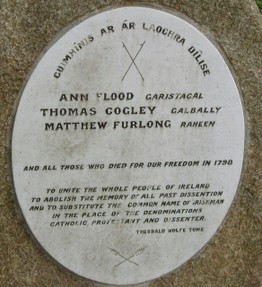 The earliest existing Claddagh rings all date from the 1700s, though there is some evidence that they were being used before. It is only the solid gold jewellery that has survived and they all bear a crown.
The earliest existing Claddagh rings all date from the 1700s, though there is some evidence that they were being used before. It is only the solid gold jewellery that has survived and they all bear a crown.
Of course, the impoverished Irishmen wouldn't have been able to afford such fine metal. Their rings would have been cheaper, hand-made and lost to history. How many of them would have shown just the heart and hands alone?
Ireland entered the 18th century having suffered defeat at the Battle of the Boyne. The British were in charge and with them came the Penal Laws.
In a country where the majority were Gaelic speaking and Catholic, these two attributes set them at a disadvantage. No Catholic could legally vote or hold office. The language of government was English. By the end of the century, the entirety of Ireland had been divided between British land-owners.
For the native Irish, allegiances became a matter of life and death. They did have the choice of converting to Protestantism and learning English. They would have to raise their children to disdain all things Gaelic, despite their own ethnicity. Even then, opportunities would remain limited with preference in all things being given to British workers emigrating to Ireland.
Those Irish who opted to keep their own language and culture were punished. Their land was seized and they had to pay rent to their new English overlords. The cost was kept high enough to plunge the Irish families into abject poverty.
Naturally the Irish continued to fight back. This was the era of the Whiteboys and Wolfe Tone. It was a century that ended with a massive pitched battle, between the English and Irish in Wexford. The spirit of rebellion never did die, for all that the British did in retaliation, and eventually the country was won back as the Republic of Ireland.
The Claddagh rings became highly popular during the backdrop of this bitter 18th century struggle. Those men adding a crown to their rings were stating loud and clear that they supported British rule. The Fenian Claddagh rings were worn by men prepared to starve or die, living the rest of their lives in poverty and persecution, rather than give up their Gaelic heritage. They did not accept the right of the British to rule over Ireland. They did not wear the crown.


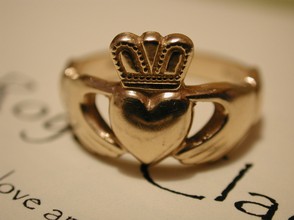



 The earliest existing Claddagh rings all date from the 1700s, though there is some evidence that they were being used before. It is only the solid gold jewellery that has survived and they all bear a crown.
The earliest existing Claddagh rings all date from the 1700s, though there is some evidence that they were being used before. It is only the solid gold jewellery that has survived and they all bear a crown.

 Before 1841, the Claddagh ring was unknown outside the twelve miles surrounding the village of Claddagh, in County Galway. Then a journalist and his wife published a three volume series of books, entitled Ireland, its Scenery, Character etc, which was widely read throughout the English speaking world.
Before 1841, the Claddagh ring was unknown outside the twelve miles surrounding the village of Claddagh, in County Galway. Then a journalist and his wife published a three volume series of books, entitled Ireland, its Scenery, Character etc, which was widely read throughout the English speaking world.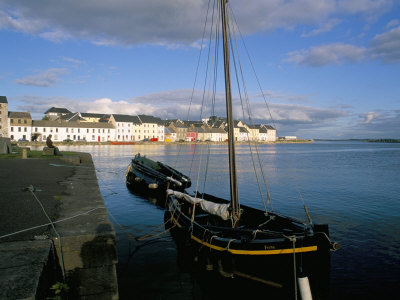






 There are lots of wonderful writers in Wizzley. They encourage, advise and share a laugh with the whole community.
There are lots of wonderful writers in Wizzley. They encourage, advise and share a laugh with the whole community.




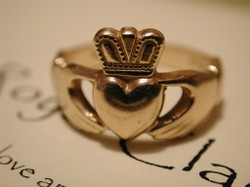

 St Tydecho's Churches in West Waleson 09/03/2014
St Tydecho's Churches in West Waleson 09/03/2014
 Goodies for an Outlander Premiere Partyon 03/06/2015
Goodies for an Outlander Premiere Partyon 03/06/2015
 Holocaust Memorial Day Interview with Rainer Höss, Grandson of Rudolf Architect of Auschwitzon 01/24/2015
Holocaust Memorial Day Interview with Rainer Höss, Grandson of Rudolf Architect of Auschwitzon 01/24/2015
 Romantic Valentine Gifts for an Outlander Fanon 01/16/2015
Romantic Valentine Gifts for an Outlander Fanon 01/16/2015

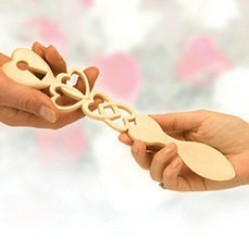
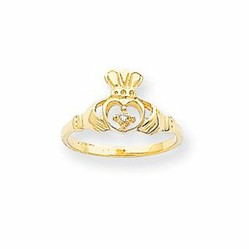
Comments
I'm glad that you liked it. Did you learn how to say the Irish terms of endearment?
I do love history in all its forms, but especially social history. When I'm writing actual history Wizzles (http://wizzley.com/authors/JoHarringt...) I do try to find the more unusual stories. They're the ones which are the most fun to research and, I hope, to read!
Thank you for reading.
What a wonderful, well-researched and well-written article! That bit of Gaelic at the end was the cherry on the cake. A bit of social history showing rings were worn by men, a bit of political history to make us understand why the crown may or may not be there, the book that made these rings popular for both men and women . . . wonderful! Look forward to your next piece :-).
Thank you very much! And it's a pleasure.
This is amazing advice on how to give a guy a Claddagh ring. Many chic's do pop the question to the man they love, this is a great guide and a perfect complimentary article to mine, rings for women. Thank you for highlighting me on your page, you are such a great Wizzley author and friend. I'm both thrilled and honored to be included. :)K
Ever since the Carter Hall books made them popular (1841-43) women have been wearing them too. That's pretty much a tradition of its own now.
I'm glad that you found this interesting.
Very interesting. I knew of the symbolism of the ring itself, but not the position and hand info. I was also unaware it was originally intended for men. Interesting to know. :)
You're a woman after my own heart. Things like this fascinate me no end. It's nice to find a subject which I can share with others too!
Thank you for commenting.
I love pages like this about old customs and culture.